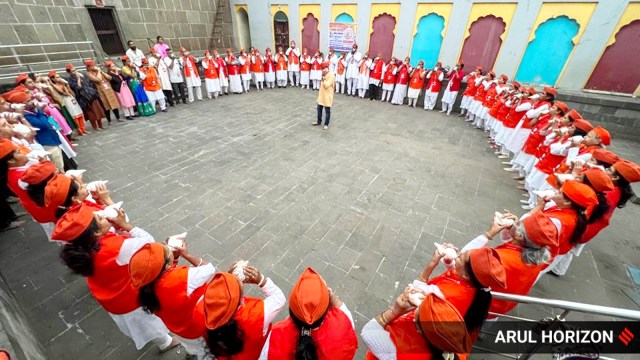Click here to join Express Pune WhatsApp channel and get a curated list of our stories
300 conch shell players to liven up Ganeshotsav
The shank players will be accompanied by cymbals, tutari, damru and dak.
 The music of Ganeshotsav might be defined by the dhol-tasha but an equally strong presence is of the shank or conch shell blowers. Keshav Shankhnaad Pathak, considered the only conch shell group in the country,(Express Photo by Arul Horizon)
The music of Ganeshotsav might be defined by the dhol-tasha but an equally strong presence is of the shank or conch shell blowers. Keshav Shankhnaad Pathak, considered the only conch shell group in the country,(Express Photo by Arul Horizon)The music of Ganeshotsav might be defined by the dhol-tasha but an equally strong presence is of the shank or conch shell blowers. Keshav Shankhnaad Pathak, considered the only conch shell group in the country, has been a quintessential part of the festivities at Dagduseth Halwai and Babu Genu Ganpati temples. Devotees will experience the power of 30 conch shell players at each of these mandals this year. The group will be performing at the Shrimant Bhausaheb Rangari Ganapati among others.
But, it will be during the visarjan that Pune will get to see the musicians at the Shree Omkareshwar Mandir. They practise the different ways of blowing shank throughout the year, amping up their efforts in August when they focus on the visarjan procession. “This year, for the first time, there will be a long procession of more than 300 shank players in the morning and the evening. Usually we have around 150 musicians, but this year, we have put together more than 600 shank players in all to create a phenomenal experience,” says Nitin Mahajan, president of the Pathak, which had also participated at Ayodhya’s Ram Temple inauguration in January 2024.
The shank players will be accompanied by cymbals, tutari, damru and dak.
The Ganesh visarjan, will be a glimpse of what Keshav Shankhnaad Pathak has planned as the celebration of its 10th anniversary. “On October 5, we will attempt a world record with a performance of more than 1111 shank players on SP College grounds,” says Mahajan. This plan traces its origins to the war of the Mahabharats in Kurukshetra, where 1111 conch shells are believed to be played to mark the war between the forces of good and evil.
“A conch shell can be played as ran dhwani or a tune of the battlefield, or mangal dhwani or auspicious music. At present, we don’t want to talk about war, so we want to highlight the triumph of satya or truth over asatya. We have created a performance plan that will begin with Brahmanad, played by Lord Shri Krishna, before moving on to the Saat Khand Naad to seek divine blessings, and the Sudarshan Naad, in praise of the sun, among others,” says Mahajan.
He adds that the vibrations of conch shells have been found to be beneficial to performers and prays for similar effect on listeners as well.
Click here to join Express Pune WhatsApp channel and get a curated list of our stories








